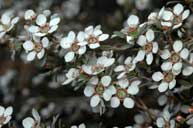In Flower This Week
A news sheet prepared by a Gardens' volunteer.
Numbers before each plant refer to temporary IFTW labels in the gardens.
Numbers in square brackets [ ] refer to garden bed Sections. Plants in flower are in bold type.
View past issues of 'In Flower This Week'.
14 October 2015
Leptospermum multicaule
click for larger image |
Today we will walk to the rear of the Rock Garden, where the warm weather has brought many plants into flower all along the path.
- Turn right as you exit the Visitor Information Centre (VIC) to see on your left Hibbertia empetrifolia [Section 210], a groundcover with small green leaves and wiry stems ending in yellow flowers, from south-eastern New South Wales.
- On your right in a pot is Chorizema cordatum [Section 174], or Heart-leaved Flame Pea, a showy plant with vivid red flowers on a weeping shrub with bright green prickly foliage. It grows naturally in the moist south-western parts of Western Australia.
- Bear left up the hill past the café. Further on your right is Grevillea ‘White Wings’ [Section 124], a large shrub with arching sprays of light green leaves and white starbursts of flower.
- As you bear right at the top of the hill, look to your left to see Chamelaucium uncinatum ‘Murfit Rose’ [Section 17], a light airy bush with needle foliage and dark pink flowers with even darker centres. This plant is a form of Geraldton Wax and the flowers darken as they age. This cultivar was developed from a chance seedling of C. uncinatum that arose in a cleared paddock at Waggrakine (near Geraldton), Western Australia.
- On the corner on your right is Ranunculus collinus [Section 78], a low green groundcover with bright yellow flowers. It is native to southeastern Australia.
- Further on your right is Leptospermum multicaule [Section 79], a small bush with tiny dark green foliage and plenty of white “tea-tree” flowers. It is native to New South Wales and Victoria.
- On your left Leptospermum brevipes [Section 120], or SlenderTea-tree, a small tree with grey-green foliage and white flowers. It is found in the wild in Queensland, New South Wales and Victoria.
- Along the top of the Rock Garden on your right is Hypocalymma angustifolium subsp. angustifolium [Section 15h], a small bush with arching sprays of pink buds and paler pink fluffy flowers fading to white. It is native to south-western Western Australia.
- Also on your right is Androcalva luteiflora [Section 15h], a rounded bush with small round foliage and yellow cup-like flowers with red centres. It grows naturally in Western Australia.
- The tall shrub with upright habit on your right is Telopea speciocissima ‘Corroboree’ [Section 15j] with bright red/pink “waratah” flower-heads. This cultivar was selected in 1974 by Nanette Cuming from seedlings of Telopea speciosissima purchased from Breakoday Nursery in Box Hill, Victoria.
- On your left is Acacia granitica [Section 3], a spreading bush with light green needle foliage and yellow balls of flowers. It grows naturally in northern New South Wales and Queensland.
- Grevillea monticola, [Section 14] on your right has prickly “holly-like” foliage with many rusty orange buds which open to small white toothbrush flowers. It is endemic to south western Western Australia.
- Look down to your right to see Acacia lineata [Section 14], or Streaked Wattle, a small bush with gold sprays of flower clusters on dark green foliage. It is found in south-eastern mainland Australia.
- On your right is Hakea horrida [Section 14], with extremely prickly, intricate needle foliage and white fluffy flowers. It is native to south-western Western Australia.
- Further on your right is Hakea macraeana [Section 20], or Needle-wood, a small tree with fine drooping foliage and white flowers along the stems. It is native to eastern Australia.
Rosalind Walcott
![Director of National Parks [logo]](../../../../images/dnp_90px.gif)







